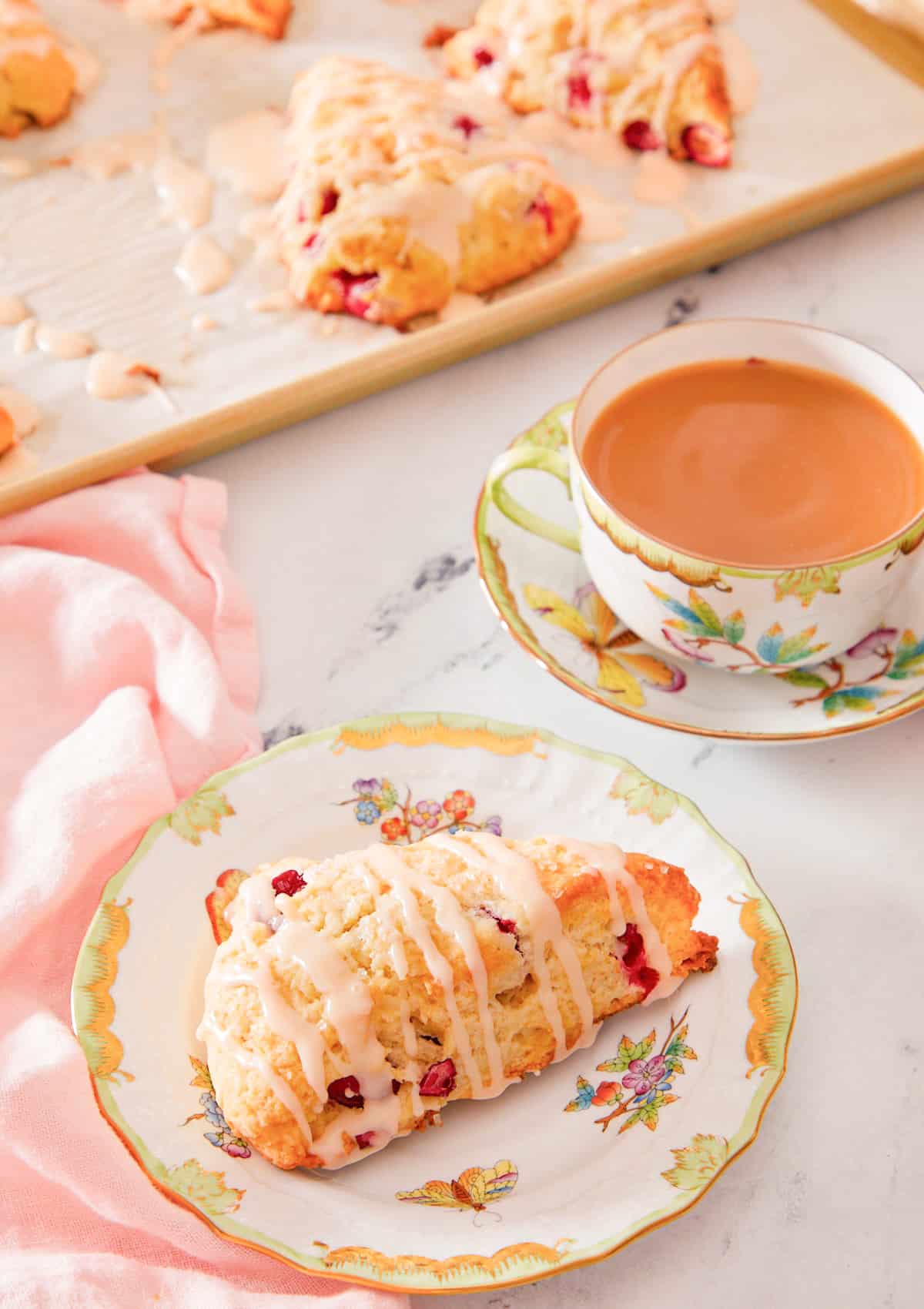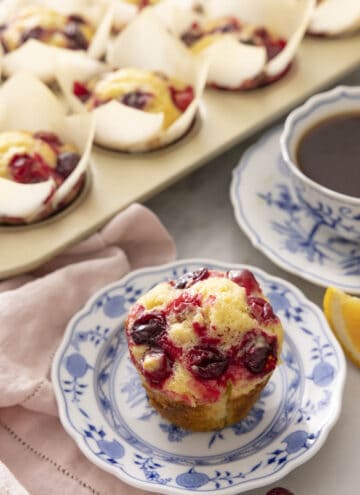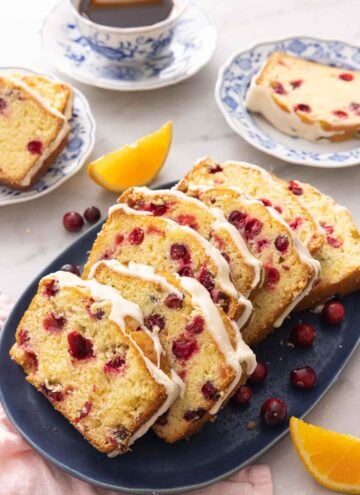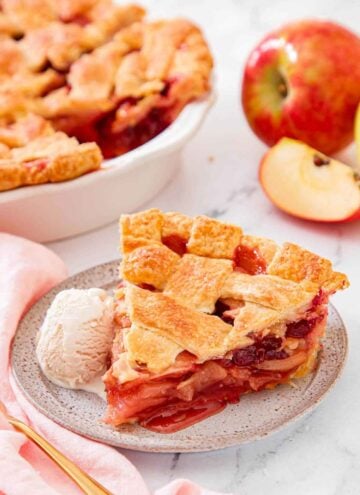These cranberry orange scones will melt in your mouth. They’re crisp and flakey on the outside while moist and tender on the inside. The combination of orange and cranberries makes for a deliciously festive flavor, making them perfect for breakfast during the holidays.
Scones may seem complicated, but they’re shockingly easy to make. You don’t need special equipment to make homemade orange cranberry scones. Simply mix the ingredients together, and you’ll have scones with sweet crumbly edges with soft, moist centers in no time. See all my tips and tricks below, and you’ll have perfect scones in no time. Want another scone recipe? Try my chocolate chip scones recipe, pumpkin scones recipe, or blueberry scones recipe.
What You Need to Make This Recipe
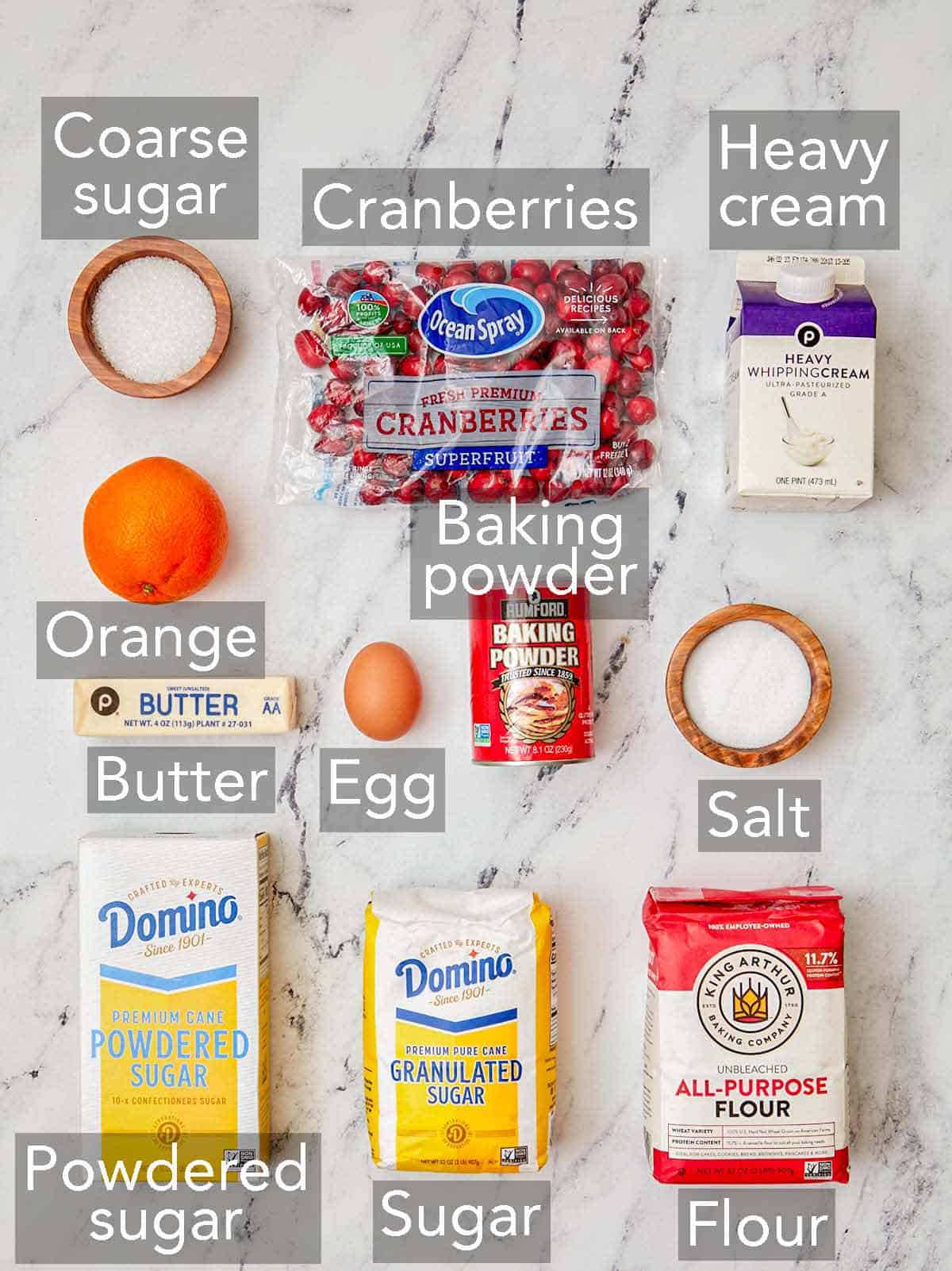
Flour — different flours have different protein amounts, so I do not recommend swapping out the all-purpose flour for a different one. You’ll need flour for the dough and to flour the surface you knead the dough on.
Baking powder — make sure your baking powder has not expired! Baking powder is how you get your orange cranberry scones to rise and be fluffy.
Butter — make sure your butter is super cold, as you don’t want the butter to melt into the dough before you bake the scones. The cold butter pieces will melt when you bake them, leaving you with flaky layers.
Orange — you’ll need some orange zest for the flavoring in the scones, and since you need orange juice in the glaze, I recommend just squeezing the orange for the juice!
Cranberries — you can use fresh cranberries or frozen cranberries for the scones!
Heavy cream — heavy cream adds richness to the dough, so the scones stay tender. Avoid swapping for whole milk or a lower percentage of cream.
How to Make Cranberry Orange Scones
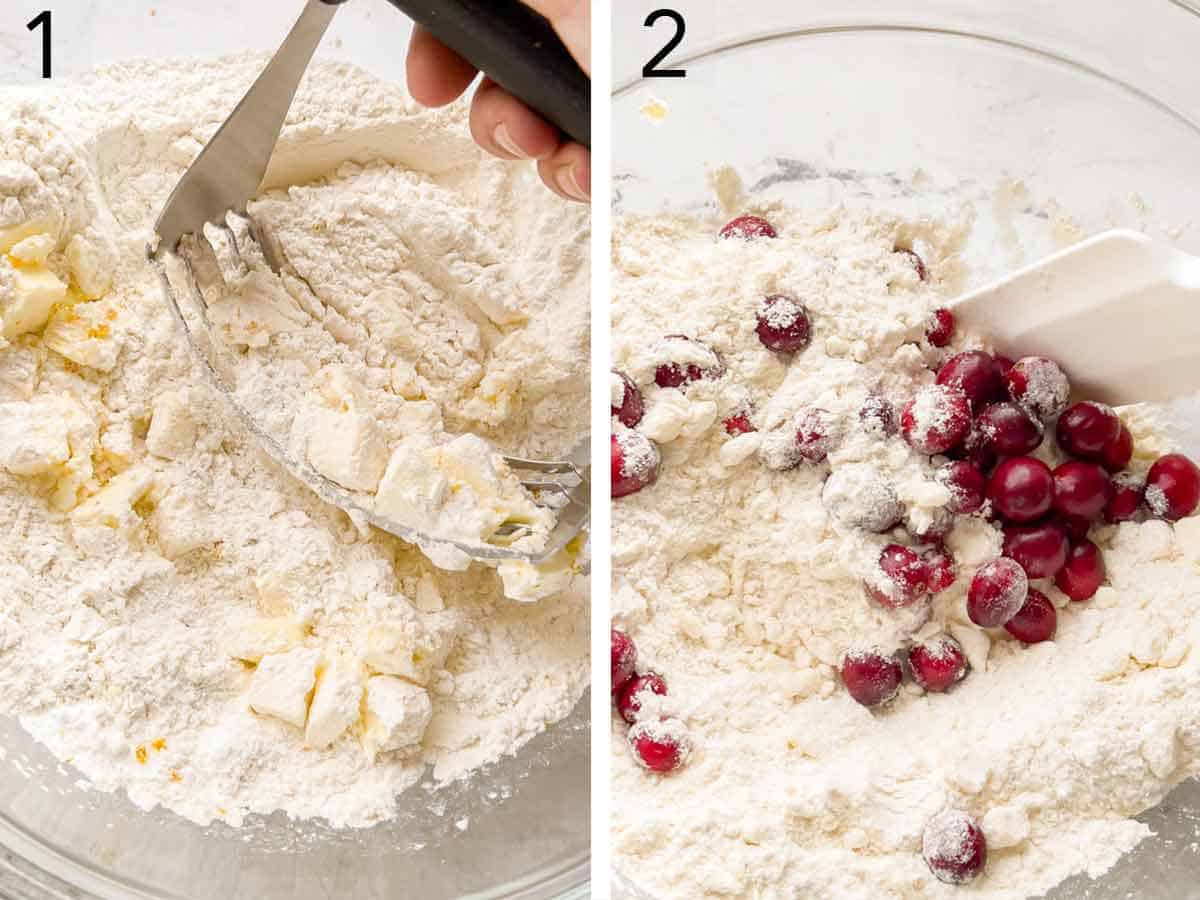
1. In a large mixing bowl, whisk together the flour, sugar, baking powder, and salt. Add the butter and orange zest and toss until well coated in flour. Using a pastry cutter or by rubbing between your fingers, work the butter into the flour until the pieces are pea-sized.
2. Stir in the cranberries.
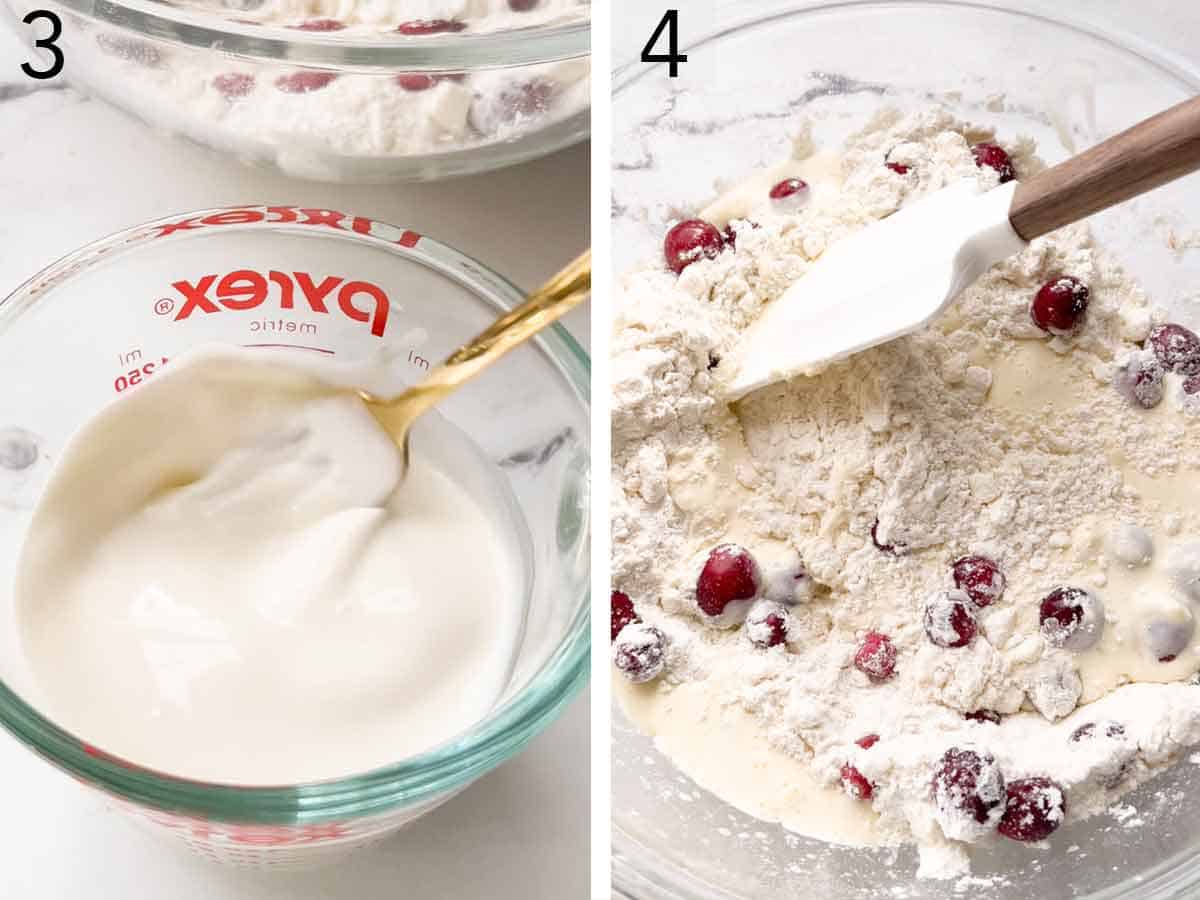
3. Whisk together the cream and the egg.
4. Make a well in the flour mixture and pour in the cream mixture. Using a spatula, fold the mixture together until a crumbly dough starts to form.

5. Pour the dough out onto the counter and lightly knead the dough. Pat it into an 8-inch circle and cut the dough into 8 wedges. Place the wedges evenly spaced on a parchment-lined baking sheet. Brush with cream and sprinkle with sugar, if desired, and bake for 20 minutes.
6. Transfer the scones to a wire rack and cool completely. As the scones cool, make the glaze by whisking together the powdered sugar and orange juice. Drizzle over the cooled scones and let the glaze set for about 30 minutes.
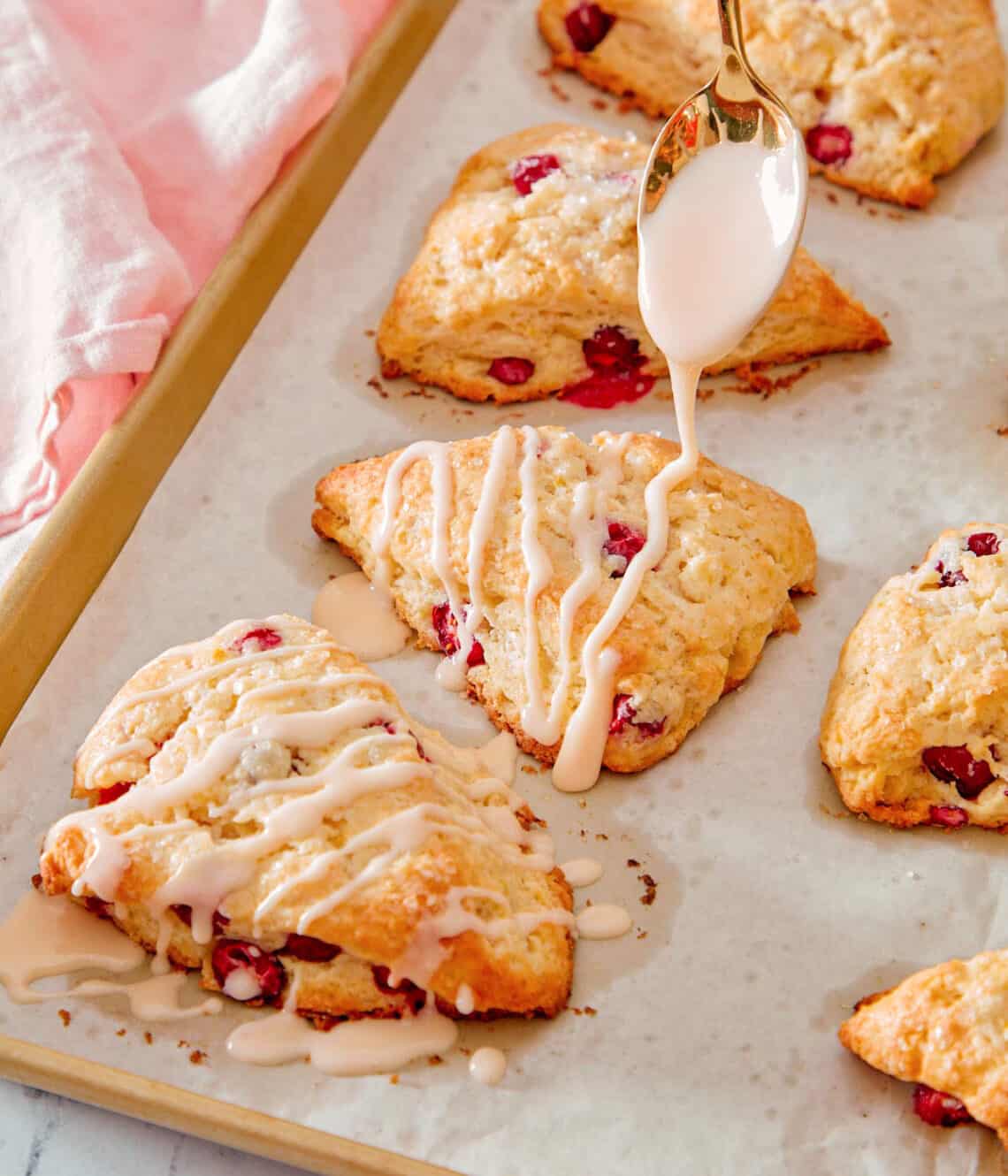
Pro Tips for Making This Recipe
- Frozen cranberries are great for this scones recipe. Frozen cranberries are great in these scones because the extra cold fruit helps to keep the butter in the dough cold while being shaped. If you don’t have fresh or frozen cranberries, you can substitute them with ½ cup of dried cranberries.
- Make sure to measure the flour correctly. If you add too much flour, the dough will become dry, and the scones won’t rise and become crumbly. The ideal way to measure flour is with a kitchen scale. If you don’t have one, fluff your flour with a spoon, sprinkle it into your measuring cup, and use a knife to level it off.
- Press straight down with the cutter or knife, and don’t twist; twisting as you cut seals the edge and prevents the scones from rising properly.
- Avoid overworking the dough to prevent gluten from forming! The more you knead, the more gluten will form, and you’ll have chewy scones. This is also why you should not use a mixer for the dough, as you’re more likely to overmix it with a mixer.
- When kneading the dough, work quickly, so the warmth from your hands does not melt the butter.
- It’s very important that while making the scones, the dough remains cold, or else the butter will start to get warm and melt. The butter needs to stay cold for these soft and flakey scones.
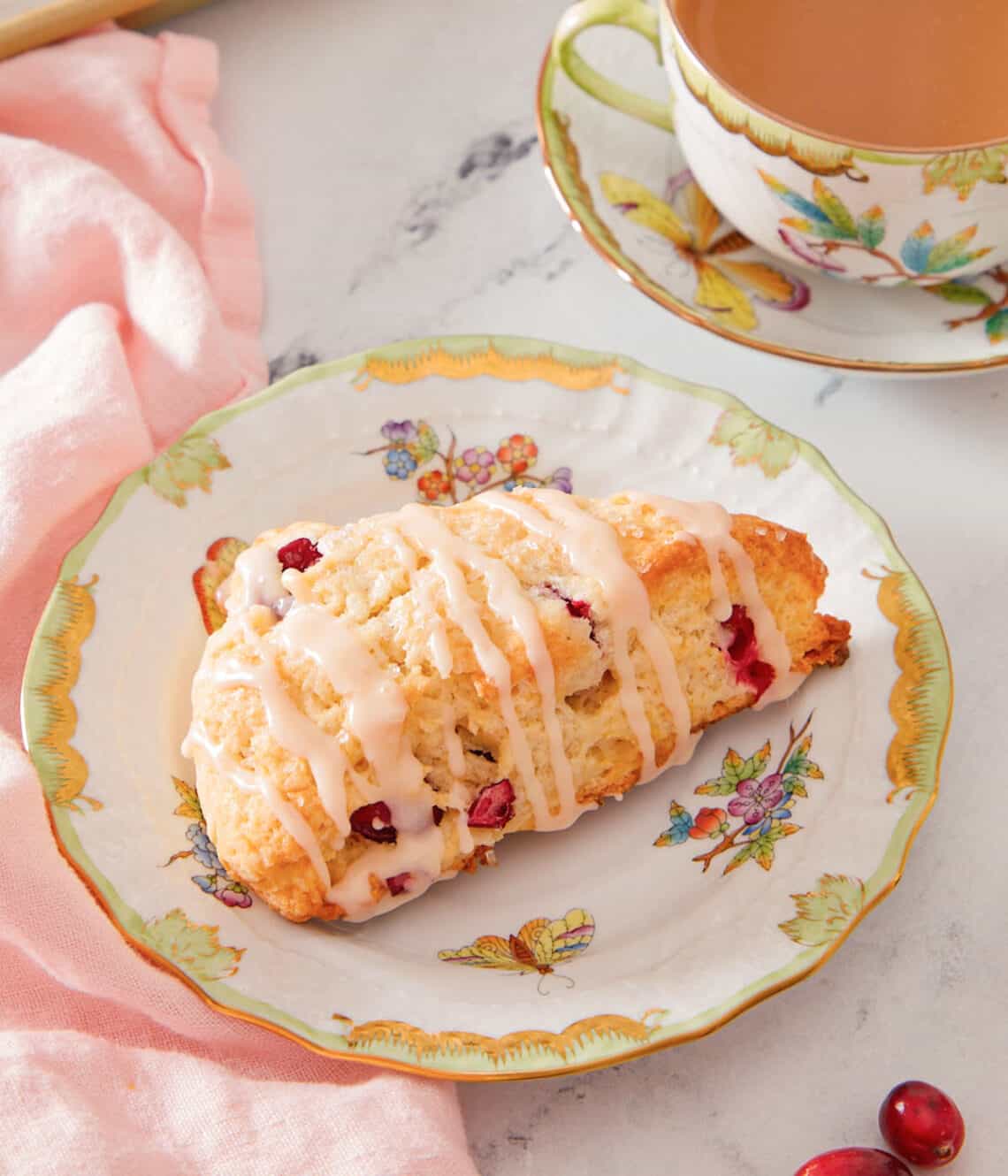
Frequently Asked Questions
Making sure your butter stays cold is key for a moist scone. The cold butter melts in the oven and creates pockets of air, leading to scones with a tender and moist center. The egg and heavy cream add to the moisture as well. Avoid using milk instead of heavy cream.
You can prepare the dough for the scones the night before and then cover and store it in the fridge overnight. When ready to bake in the morning, cut the dough and brush with cream.
Store leftover scones covered at room temperature for up to 2 days.
If you’d like to freeze the scones, skip glazing them. Once the scones are at room temperature, freeze them in a freezer-friendly bag or container. To thaw, leave it at room temperature for a few hours or overnight in the fridge. Reheat them in the oven or microwave and drizzle with the glaze.
If you’ve tried this Cranberry Orange Scones recipe, then don’t forget to rate the recipe and let me know how you got on in the comments below, I love hearing from you!

Cranberry Orange Scones
Equipment
- Mixing Bowls
- Pastry cutter (optional)
- Large baking sheet
- Parchment paper
Ingredients
For the Scones:
- 2 cups all-purpose flour (240g)
- ⅓ cup granulated sugar (66g)
- 2½ teaspoons baking powder
- ½ teaspoon salt
- ½ cup cold unsalted butter, cubed (113g)
- 1 tablespoon orange zest (about 1 orange)
- 1 cup fresh or frozen cranberries (110g)
- ½ cup cold heavy cream plus more for brushing (120ml)
- 1 large egg
- Coarse or granulated sugar for sprinkling
For the Glaze:
- 1 cup powdered sugar (120g)
- 2 tablespoons freshly squeezed orange juice
Instructions
For the Scones:
- Preheat the oven to 400F. Line a large rimmed baking sheet with parchment paper.
- In a large mixing bowl, whisk together the flour, sugar, baking powder, and salt. Add the butter and orange zest and toss until well coated in flour. Using a pastry cutter or by rubbing between your fingers, work the butter into the flour until the pieces are pea-sized. Stir in the cranberries.
- Whisk together the cream and the egg. Make a well in the flour mixture and pour in the cream mixture. Using a spatula, fold the mixture together until a crumbly dough starts to form.
- Pour the dough out onto the counter. With floured hands, lightly knead the dough just until it starts to form a cohesive mass. Pat into an 8-inch circle. Using a sharp knife or a bench scraper, cut the dough into 8 wedges.
- Place the wedges evenly spaced on the baking sheet. Brush with cream and sprinkle with sugar, if desired. (For extra flakey scones, refrigerate or freeze for 20 minutes.)
- Bake for 20 minutes or until the tops are golden brown. Transfer the scones to a wire rack and cool completely.
For the Glaze:
- In a small mixing bowl, whisk together the powdered sugar and orange juice. Drizzle over the cooled scones and let the glaze set for about 30 minutes. Store covered at room temperature for up to 2 days.
Notes
- Frozen cranberries are great for this scones recipe. Frozen cranberries are great in these scones because the extra cold fruit helps to keep the butter in the dough cold while being shaped. If you don’t have fresh or frozen cranberries, you can substitute them with ½ cup of dried cranberries.
- Make sure to measure the flour correctly. If you add too much flour, the dough will become dry, and the scones won’t rise and become crumbly. The ideal way to measure flour is with a scale. If you don’t have one, fluff your flour with a spoon, sprinkle it into your measuring cup, and use a knife to level it off.
- Press straight down with the cutter or knife, and don’t twist; twisting as you cut seals the edge and prevents the scones from rising properly.
- Avoid overworking the dough to prevent gluten from forming! The more you knead, the more gluten will form, and you’ll have chewy scones. This is also why you should not use a mixer for the dough, as you’re more likely to overmix it with a mixer.
- When kneading the dough, work quickly, so the warmth from your hands does not melt the butter.
- It’s very important that while making the scones, the dough remains cold, or else the butter will start to get warm and melt. The butter needs to stay cold for the soft and flakey scones.



